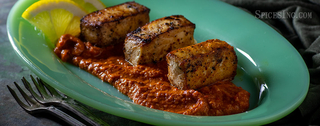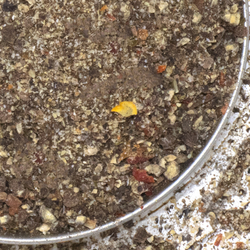Swordfish with Nora Pepper Romesco Sauce

First, we’d like to clear up one thing about Romesco Sauce. Despite the name, this sauce? Is not a product of Rome. The Spanish city of Tarragona, located on the northeastern coastline about an hour south of Barcelona, is credited as Romesco Sauce’s home town. Even more specifically, this recipe was developed by local fishermen in El Serrallo, a dockside area of Tarragona, in the style of Roman-esque sauces. Hence the name. They used available ingredients, like the sweet Nora Chiles that are local to northern Spain, as well as roasted tomatoes and Spain’s own buttery-rich Marcona almonds, to create a pounded paste called a picada. This picada was then used to season soups and fish stews, or thinned out a little to make a sauce. Romesco was celebrated as a regional specialty early in the 20th century, and rudimentary outlines of Romesco recipes have been found in cookbooks from the 19th century.
Romesco Sauce is not difficult to make; remember, it was originally made alongside some boats at a Spanish dock. It is a classic example of simple and well-chosen ingredients, done right, provided you give everything the right amount of time to cook. Rehydrated Nora Chiles are the traditional choice of pepper for this dish, with their mild heat, earthy flavor and broad popularity in Spanish cuisine. You could also choose Dried Choricero Peppers for this recipe, since they exude Spanish culinary sensibilities with their sunny flavor and negligible spiciness. In order to make this dish properly we recommend against trying to use roasted red bell peppers. Though they are delicious in their own right, this sauce excels thanks to the concentrated flavors that are found in dried peppers.
Cashews were the nut of choice for this dish simply because of personal preference; you can use Marcona almonds for authenticity, regular almonds, or hazelnuts. We used a chewy, crusty piece of white bread to give the sauce extra body. Yes, you can use sourdough, but avoid breads like rye or pumpernickel, which can throw off the flavor of the sauce. The bread can be slightly stale, but if it’s too old and dry it will absorb the moisture in the sauce and require more liquid to create a lump-free paste. You want bread that’s still got a little bit of squish in it. To get that sour bite, use sherry vinegar, made in Cadiz, Spain. It delivers a beautiful complexity that’s carried forward from the barrels in which sherry is aged—deep and woody, with playful acidity. If you cannot find sherry vinegar, the fruity tartness of red wine vinegar is a good substitute. And if you want a little bit of heat, you can add smoked hot paprika [link] instead of smoked sweet paprika when you combine everything, but this sauce is not about spicy heat at all.
We decided to pair our Romesco Sauce with swordfish and make them into small, tapas-like bites to honor the Spanish maritime history of this sauce. Marinated in lemon juice and Pennsylvania Pepper, this white, meaty fish has been brightened up with lemon and spiky with pepper and is a delicious contrast against Romesco’s smooth, sweet richness. Swordfish is a substantial fish, oily and hearty, so it can assert itself among the flavor of Romesco Sauce in a way that a mild, flaky fish like cod cannot. If swordfish isn’t available, look for something that’s got a bold flavor, like salmon. Browning the sides of the fish at high heat adds textural snap and an extra dash of umami flavor, and it only takes a few minutes; any longer than two minutes per side is too long, especially since the cubes of fish are fairly small. Serve these tapas nestled into a bed of Romesco Sauce, with an extra squeeze of lemon at the end. Enjoy them as is, or sit the swordfish on a toasty crostini with a big dollop of Romesco Sauce on top for a delicious bite of the Spanish countryside.
- 1 pound swordfish steak
- Juice from one lemon
- 6 Tablespoons olive oil, divided
- 2 teaspoons Fine Sea Salt, divided
- 1 teaspoon Pennsylvania Pepper
- 5 Dried Nora Chiles
- 8 ripe plum tomatoes
- 1 red bell pepper
- 1 small yellow onion, cut in half
- 1/4 cup cashews
- 1 ounce (roughly one thick slice) bread, with crusts removed
- 2 teaspoons La Vera Smoked Sweet Paprika
- 1 Tablespoon sherry vinegar
1. Cut swordfish into 2-inch cubes. Marinate them in lemon juice, 3 Tablespoons olive oil, 1 teaspoon Fine Sea Salt, and Pennsylvania Pepper. Refrigerate for at least 30 minutes and up to an hour.
2. Rehydrate Nora Peppers for 20 minutes in hot water, then drain, de-seed, and set aside.
3. Roast plum tomatoes, red bell pepper, and onion in a 400 degree oven for 20 to 25 minutes, or until slightly charred. Turn occasionally to ensure even charring. When the vegetables have cooled slightly, peel the skins off and de-seed the tomatoes.
4. Toast cashews in a medium-hot pan until slightly golden brown.
5. Tear bread into small, workable pieces and put in a food processor. Pulse a few times to make bread crumbs. Combine vegetables, cashews, Nora Peppers, La Vera Smoked Sweet Paprika, sherry vinegar, and remaining teaspoon Fine Sea Salt with bread crumbs in a food processor and puree. Slowly drizzle in the other 3 Tablespoons of olive oil and puree until smooth but thick.
6. Remove swordfish cubes from marinade and dry them slightly. Brown the swordfish over medium-high heat, letting each side cook for 1 to 2 minutes.
7. Spoon 2 Tablespoons Romesco Sauce onto a plate. Nestle in 3 swordfish cubes per serving; garnish with lemon wedges or fresh parsley.



